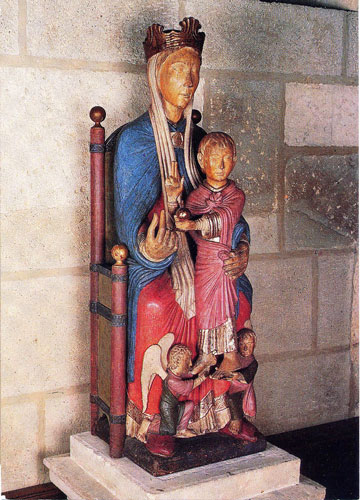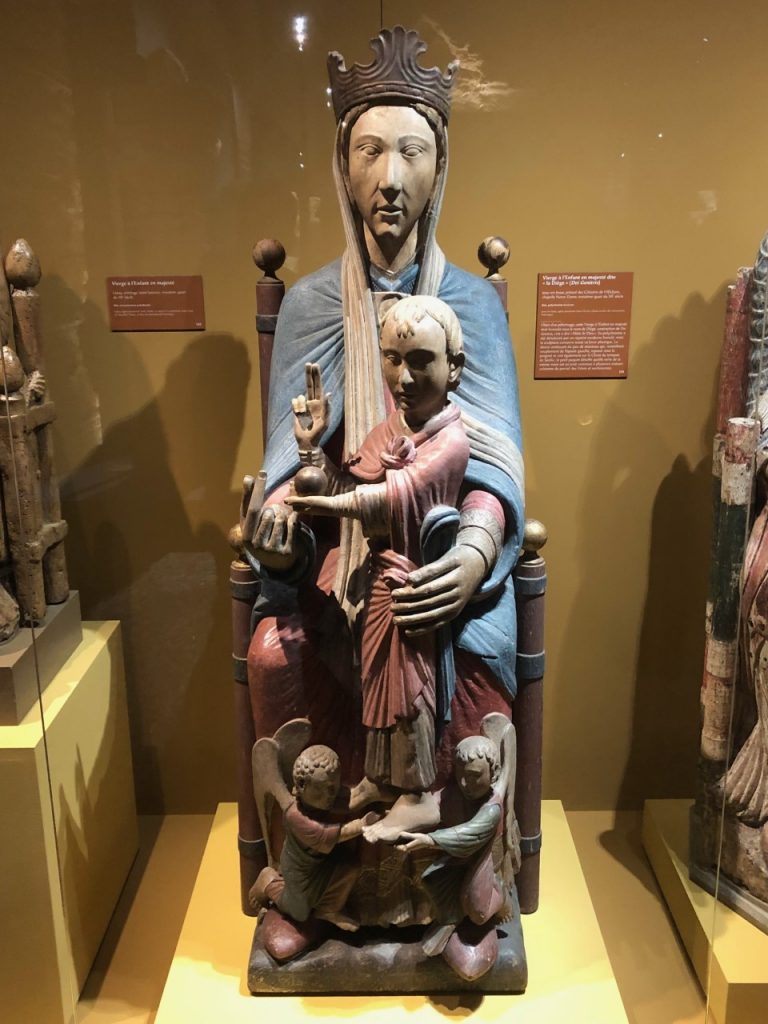The Diège
Do you know the meaning of “Diège”?
It is the alteration of the Latin words “Dei Genitrix” which means “mother of God”.
The representation of the Virgin and Child in Jouy-en-Josas is composed of some historical and artistic particularities (the most observant have guessed what it is about…).
ITS HISTORICAL PARTICULARITIES
Jewel of the church Saint-Martin of Jouy-en-Josas, “La Diège” is a polychrome wooden statue of the 12th century.

This Virgin and Child was honored in the Middle Ages in the chapel of Notre Dame de Villetain, located on the Saclay plateau.
At the end of the 18th century, the chapel fell into ruin and the statue was moved to the church of Jouy-en-Josas.
Then, hidden in a farm during the revolution, in a sort of niche formed by a window walled in and out, it was forgotten. It was found by chance half a century later during construction.
It then returned to the church, installed surrounded by a gate, in front of a wall covered with a mosaic that condemned the door leading to the former cure.
The statue is now in the chapel dedicated to the Virgin and protected in a glass cage. Nowadays, the Liege is still the object of a great devotion.
La Diège was classified as a historical monument by decree of April 11, 1902.
ITS ARTISTIC PARTICULARITIES
This Virgin, in majesty, is in the Christian iconography an artistic representation of the Virgin Mary, figure enthroned in the earthly world.
This group is composed of four characters.
The mother is seated; the child Jesus, who is not a baby, is represented standing. The child’s feet are carried by the hands of two angels kneeling at the feet of the Virgin, who is effacing herself before her already grown son, whom she puts forward. She does not touch him directly, no doubt to show her respect for the God-child. The child carries in his left hand the globe symbolizing his power over the earth, which he blesses with his right hand, the thumb, index and middle fingers raised in the gesture of the Latin blessing.
Its rigid form, the stiff and tight folds of the robes and veils that cover it, the hands and feet of the mother and child larger than life are characteristics of Romanesque statues.
The question arises as to whether this statue was originally polychromatic.
In the 19th century, it was entrusted to Viollet-le-Duc who had it redone according to his taste, in a very outrageous manner that did not please.
In the 1960’s, it passed into the hands of restorers who realized that none of the coloring was prior to the 19th century. Viollet-le-Duc’s polychromy was softened and the stars he had painted on the mantle were removed.
Texts written thanks to the Groupe de Recherches Historiques de Jouy-en-Josas
This Romanesque Virgin was exhibited at the Petit Palais in 1974. More recently it was exhibited at the Cluny Museum, in Paris, from October 10, 2018 to January 21, 2019 at the exhibition “Birth of Gothic sculpture. Saint-Denis, Paris, Chartres 1135 – 1150”.

PRACTICAL INFORMATION
To admire it, go to the Saint-Martin church – 11 rue Pierre Bonnard in Jouy-en-Josas.
Open all year round, from 9 am to 6 pm (except during religious ceremonies), closed on Mondays.
Free admission.
To contact the parish : 01 39 56 42 64 or on its website.